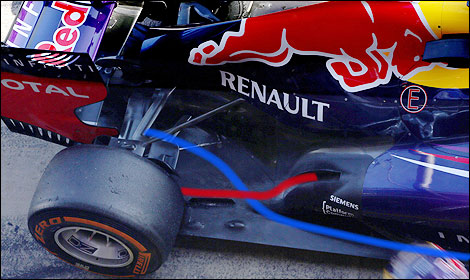Mar
27th
Stay connected Subscribe to our RSS feed
Most Formula 1 teams are working hard to fine-tune the exhausts of their engines to generate additional downforce and increase performance.
After the FIA regulated the positioning of exhaust tips, engineers started working on the shape of the surrounding bodywork.
Aerodynamicists worked on what is called the “Coanda effect.” It is described as the tendency of a fluid jet to be attracted to a nearby surface. The principle was named after Romanian aerodynamics pioneer, Henri Coanda.
Here is one simple example of the Coanda effect: Try to extinguish a candle, but first place a bottle in front of it. Although there is an obstacle between your mouth and the candle, you'll succeed. The Coanda effect allows the air coming from your mouth to stay attached to the curved surface of the bottle. Both streams will then reattach on the other side of the bottle, blowing out the candle.
In Formula 1, the Coanda effect is design to redirect exhaust gases to run through the rear diffuser with the intention of increasing downforce.
In this case, the hot gases follow the natural contour of the bodywork, directing them towards the trailing edge of the diffuser and producing an invisible seal made of hot air. This increases downforce from the diffuser, making the car run faster in the corners.
After the FIA regulated the positioning of exhaust tips, engineers started working on the shape of the surrounding bodywork.
Aerodynamicists worked on what is called the “Coanda effect.” It is described as the tendency of a fluid jet to be attracted to a nearby surface. The principle was named after Romanian aerodynamics pioneer, Henri Coanda.
 |
| In blue: the cold air that follows the sidepod, and in red, the hot air that follows the bodywork. (Photo: WRi2 / Graphics: Stéphane Faucompré) |
Here is one simple example of the Coanda effect: Try to extinguish a candle, but first place a bottle in front of it. Although there is an obstacle between your mouth and the candle, you'll succeed. The Coanda effect allows the air coming from your mouth to stay attached to the curved surface of the bottle. Both streams will then reattach on the other side of the bottle, blowing out the candle.
In Formula 1, the Coanda effect is design to redirect exhaust gases to run through the rear diffuser with the intention of increasing downforce.
In this case, the hot gases follow the natural contour of the bodywork, directing them towards the trailing edge of the diffuser and producing an invisible seal made of hot air. This increases downforce from the diffuser, making the car run faster in the corners.
 The latest auto news, reviews, prices, product and vehicle releases.
The latest auto news, reviews, prices, product and vehicle releases.